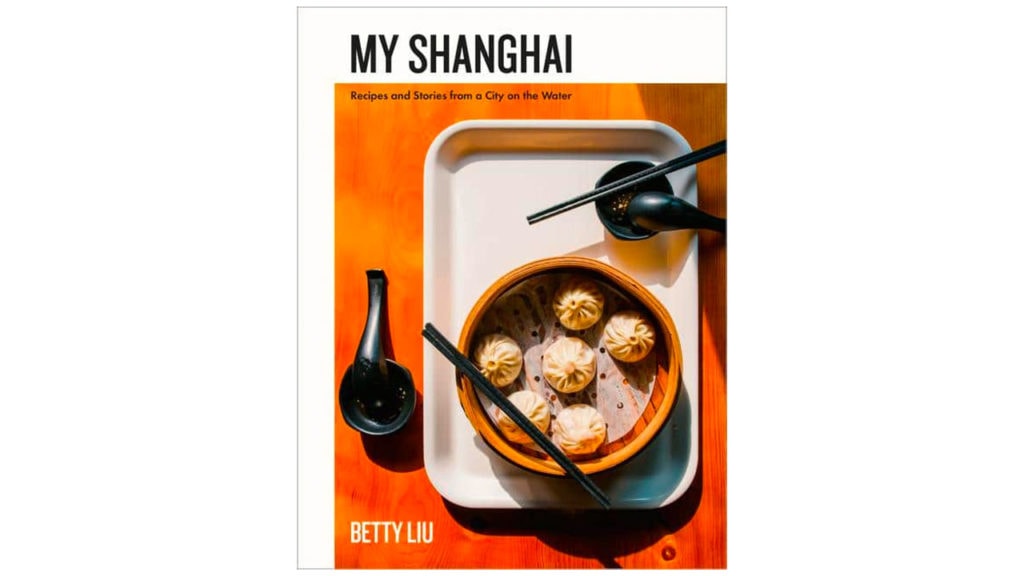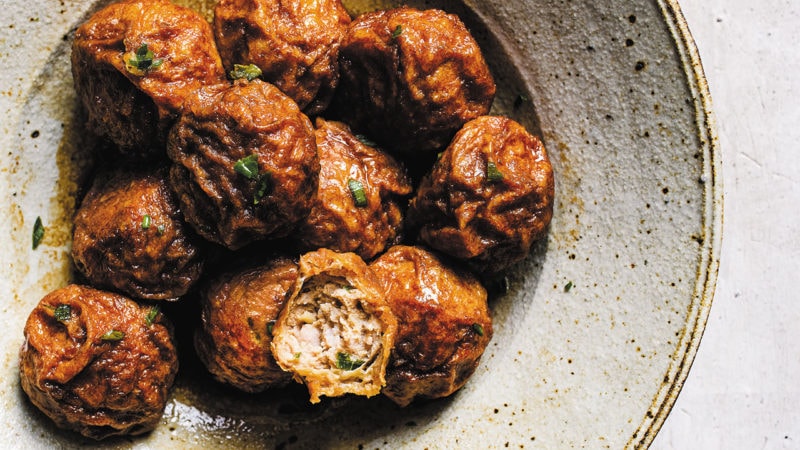Last Updated on May 12, 2021
When Betty Liu started posting to her blog in 2015, she dreamed of mastering a favorite childhood dish: Hong shao rou, or red-braised pork belly. At the time, Liu was living in St. Louis for college and missed the tangy soy-sauce flavors from her mom’s Shanghainese cooking.
So she convinced her mom to send her off with frozen wonton and zong zi (sticky rice wrapped in bamboo leaf) tucked in her suitcase—a delicious reminder of her Bay Area home. While these souvenirs offered solace during bouts of homesickness, Liu knew she couldn’t rely on her mom’s cooking forever.
Becoming an Intuitive Cook
Intent on learning her family’s recipes, Liu started hanging around her home kitchen during her school breaks. She marveled over how her mother effortlessly stirred soy sauce with ginger and scallion and caramelized chunks of pork belly. Instead of memorizing specific measurements, her mother had learned cooking by watching other families in a communal kitchen, and her work ethic inspired Liu to build the same intuition. As her mom tended to the flaming wok, Liu jotted recipe notes for her own cooking sessions, keen on replicating her mother’s kitchen charm.
Perfecting her mother’s hong shao rou took hours of trial and error, but once she cooked it to her liking, Liu posted the recipe to her blog for her own records. It wasn’t long until her mother’s recipe and stunning photos attracted fans from all corners of the internet. She soon heard from people—“My mom used to make this for me” and “This reminds me of when I was in China.”
Other Chinese Americans identified with Liu’s goal to learn recipes from her childhood, and she found a community encouraging her to publish more recipes.
Growing a Community, Growing as a Cook

She returned to the kitchen eager to test out her family’s recipes and create some recipes of her own, including black sesame karaage and spicy Sichuan shakshuka. As more fans flocked to her site, she started dreaming up a cookbook dedicated to Shanghainese cuisine. Her cookbook, My Shanghai: Recipes and Stories from a City on the Water, was released on March 9, 2021.
Six years in the making, My Shanghai dives into the recipes, history, and legends of a regional cuisine. But before her project even began, Liu realized a pressing need for a cookbook like hers.
“There are a couple of books on regional Chinese cooking. A lot of them are written by people who are not Chinese,” she says. “They do a good job in researching the area, but ultimately these recipes are taught to them by other people. And evidently, the books are written through the lens of someone who is not Chinese.”
Years of celebrating Chinese rituals, eating Shanghainese food, and cooking, eating, and talking with her family have shaped Liu’s final cookbook. Liu even flew back to Shanghai to research the cuisine alongside farmers and chefs. Trips to Shanghai to visit family were always the norm for Liu, but this time, her adventures led her to crab fisheries and bamboo foragers. In her book, she traces the stories behind counterfeit markets for hairy crabs and flaky street foods during mid-Autumn festivals.
Visiting the Source
In Shanghai, she also observed chefs cooking with fresh and regional ingredients. Preserving this seasonal spirit became essential to Liu. She decided to not modify her recipes that included unfamiliar ingredients, such as pigs feet or mountain yam, out of convenience, especially when these ingredients have been more accessible than ever on the Internet.
“I took a step back when I was writing my proposal and I made a very conscious decision to not think about [modifications],” she tells me. “Because if I really want to do this cooking justice, I need to write in a way that really portrays it as what it is versus tailoring it to the white palate. There are enough books and enough restaurants that do that.”
Unlike many other cookbook authors, Liu juggles a demanding full-time job—she works 80-hour weeks as a surgery resident in Boston. Throughout it all, she has powered through blogging and finalizing touches on the recipes and cookbook design. Balancing a residency schedule drains most of her time these days, but she draws energy from sharing her cooking and techniques with others.
A Love Letter to Chinese Food
“I think Chinese food is often seen as something really intimidating and scary to cook, but people cook it at home all the time and it’s more flexible and forgiving than people think it is,” she says. “I’m hoping that this book will kind of break down that barrier and make it accessible for anyone.”
My Shanghai is Liu’s love letter to Shanghainese food, and her recipes are delicious—like this recipe for one of Betty’s signature dishes, Pork-Stuffed Fried Dough.
Pork-Stuffed Fried Dough
油面筋塞肉 | yóu miàn jīn sāi ròu | Makes 30 fried-dough meatballs
When I told my father-in-law that I was writing a book, this was the first dish he told me to include. It’s a bit hard to translate and describe, but it’s essentially an oil-fried dough stuffed with meat, which is then cooked in a tasty broth. The fried dough soaks up all the broth and becomes wrinkly, like a soaked cloth.
This recipe makes about thirty meatballs, but you can stretch it further by stuffing each one with less meat than I recommend to create doughier, wrinklier meatballs—it’s all up to you.
NOTE: After stuffing all the balls, you may also have filling left over. At this point, the moisture from the filling will actually have softened and broken down the fried dough interiors, so that there is more give inside, providing you more room to stuff in a bit more filling.
NOTE: Adjust the cooking time depending on how large the meatballs are and how much meat is in each one. You can always cut one open to check doneness.
FRIED-DOUGH MEATBALLS
30 oil-fried dough puffs (available at Asian markets)
1 pound ground pork
2 tablespoons light soy sauce
2 tablespoons dark soy sauce
1 tablespoon granulated sugar
¼ teaspoon ground white pepper
2 tablespoons Shaoxing wine
1 teaspoon cornstarch
1 large egg, beaten
3 tablespoons Ginger-Scallion Water (page 257)
COOKING BROTH
(for 8 meatballs) makes 2 to 4 servings
1 tablespoon neutral cooking oil, such as canola or grapeseed oil
1 slice fresh ginger
1 scallion, cut into 1-inch segments
2 whole star anise
2 tablespoons Shaoxing wine
¼ cup just-boiled water
1 tablespoon light soy sauce
1 tablespoon dark soy sauce
2 teaspoons rock sugar
Sesame oil
INSTRUCTIONS
- MAKE THE FRIED-DOUGH MEATBALLS: Prepare the fried dough puffs by sticking a chopstick into each puff to create a hole without going through to the other side. Use your fingers to gently break up the fibers in each puff, hollowing it out to become a sphere. Set aside.
- In a medium bowl, combine the pork, light and dark soy sauces, sugar, white pepper, wine, cornstarch, and egg, and mix with chopsticks or a small spatula in one direction (see page 133, step 1). Add the ginger-scallion water. Use chopsticks to mix in one direction until the mixture resembles a sticky paste.
- Stuff 1 tablespoon of the meat into each fried dough puff with a small spatula or spoon. At this point, you can freeze the meatballs for later (thaw them before using), or cook some of them in the broth.
- MAKE THE BROTH: Heat the oil in a pan over medium. Fry the ginger, scallion, and star anise until fragrant.
- Place the meatballs, opening side down, in the pan in a single layer and cook undisturbed for 30 seconds to seal the meat in. Gently add the wine and cover the pan immediately for 30 seconds. When the alcohol has evaporated, add the just-boiled water, light, and dark soy sauces, and sugar.
- Bring to a boil over high, then reduce the heat to medium-low. Braise the meatballs, partially covered, for 15 to 20 minutes. The sauce will be absorbed deliciously into the now wrinkly dough. Finish with a few drops of sesame oil.
From the book MY SHANGHAI by Betty Liu. Copyright ©2021 by Betty Liu. Published by Harper Design, an imprint of HarperCollins Publishers. Reprinted by permission. Photograph by Betty Liu.
Jess Eng is a freelance writer, food zine and cookbook author, and data visualization enthusiast from San Francisco, CA. Her work and recipes have been published in The Washington Post, NPR, Atlas Obscura, and KQED. You can find her on Twitter @jessicaeng17



